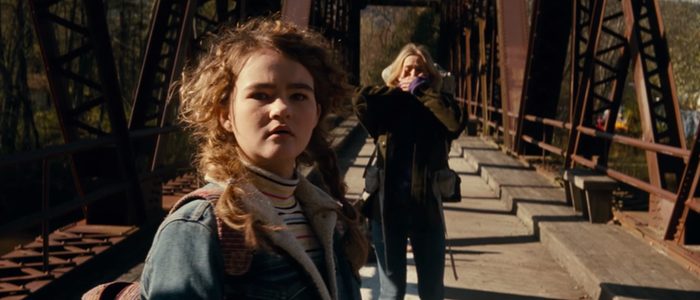Blueprints: "A Quiet Place"
 Friday, April 20, 2018 at 12:52AM
Friday, April 20, 2018 at 12:52AM This week, Jorge dives deep into the unconventional formal elements inside the screenplay of the number one film in the country right now.

A Quiet Place is an immersive experience. The film centers around a dystopian future, in which creatures that are attracted to sound have taken over. In order to stay alive, a family has to stay totally silent through their everyday lives.
The film utilizes sound (the lack of, its intensity, its threat) as a formal device to guide us through the narrative. There is barely any spoken dialogue. Everything is conveyed visually, using alternative devices than those we are used to seeing in film. It is an experiment in form. Its screenplay is much the same. Using devices that are rarely found in a regular script, the writers create an immersive, completely different experience that lets the reader know right away that this is not your regular horror flick...
A Quiet Place
Written by: Bryan Woods & Scott Beck and John Krasinski
Just as there is not one right way to make a movie, there is not one right way to write a screenplay. But there is are accepted, tried-and-true methods to do both; elements and guidelines that are encouraged to be used, for the palatability of both audiences and readers.
Arguably, A Quiet Place (the finished film) throws some of those guidelines out the door and establishes its own rules; creates its own way for people to experience it. And in a less arguable way, the screenplay does the same. It plays with the form, rules, and structure of what a “regular” screenplay should do, in order to convey and augment the emotion of the story.

***

Action lines in scripts are usually written in concise, full sentences that do their best to describe the actions of the characters. It’s the part of the screenplay that is more prose-like. But in this script, the writers chose in strategic parts to make it more poetry-like. They play with the size, placement, and formatting of the words for emphasis. Reading it creates tension: the feeling of being chased, the fear of being attacked, the threat of a nail in a staircase.

***

Scripts are usually written entirely in a single font (Courier is the standard). At a glance, all pages should look vaguely the same to the naked eye. Just blocks of lines and dialogue that come alive once you start reading.
However, A Quiet Place decides to throw in different fonts to immediately make certain phrases stand out and make them more visually vibrant. The reader sees them the way the characters are seeing them. They make us a bigger and more dynamic part of the story than if we were just reading it; now we’re also seeing it. A newspaper headline, a list of kill attempts, the scribbles of a diary.

***

***

But we’re not just seeing text. The script also provides visual clues and representations of actual props and objects that will be used in the film. It’s the epitome of one of the essential cornerstones of screenwriting: show, don’t tell. This golden rule is elevated perhaps to a transgressive level, but it is incredibly useful to visualize things that may be hard to just read (like the spatial layout of the land), or have quirky visual cues that will become relevant later (identifying stickers, which were cut from the final draft of the movie).

***

The script goes as far as to plat with the use of black and white space in the page. In a segment of the screenplay that is too long to include in this column, there is a series of pages which include nothing but single numbers counting one by one down to a catastrophic and tragic event. On the opposite end, when the characters are supposed to be engrossed in darkness, the highlight of the text inverses, and black becomes white.

***

It should be said that none of these tricks and gimmicks (which, at the end of the day, is what they are) would be as effective is there wasn’t an equally compelling and engrossing story to back them up. This is why writers are highly discouraged to fill their script with distracting fonts, formatting, and images. If the work is not there to support it, they just become confusing.
Fortunately for A Quiet Place, these devices were congruent with the type of story that was being told, in which the regular style was no longer sufficient. Just as the family in the film had to adapt to live in a world with no sound, the writers decided to adapt the script of the story for this environment, as well. Make it more visually vibrant, turn every sound and emotion into something palpable in the page. It shouldn’t work, but just like complete silence, it takes over you.



Reader Comments (2)
Suddenly, I REALLY want to read this screenplay. This is FASCINATING.
Also, thanks for this series, Jorge - it is consistently great to read!
That seems very cool. However, the more I think about the final product, the more I am infuriated by the use of music. Really deflates much of the tension.